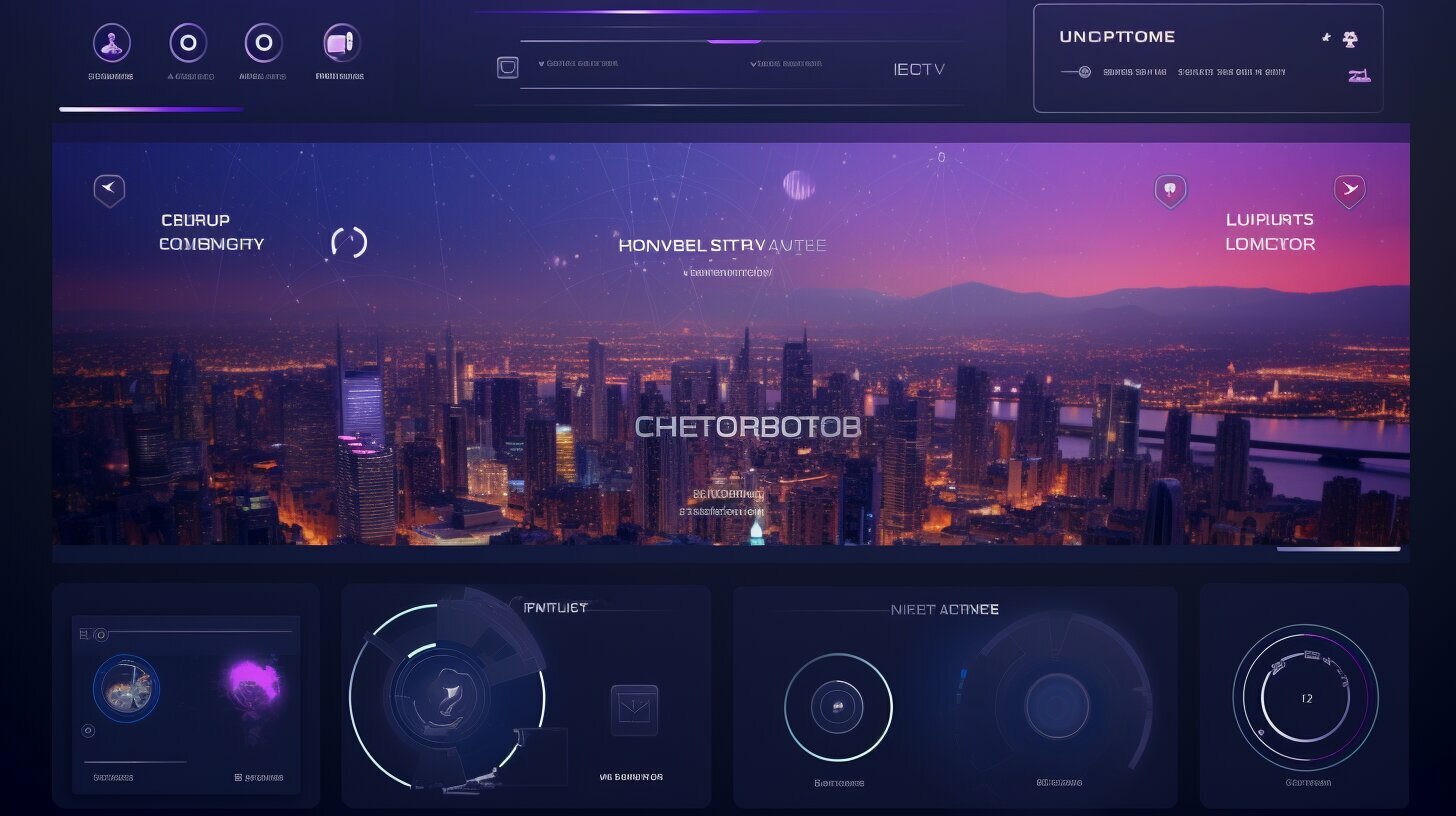Creating a successful PPC campaign requires a deep understanding of PPC advertising and the implementation of effective strategies. From conducting extensive keyword research to crafting compelling ad copies, every step plays a crucial role in achieving impactful results. In this comprehensive guide, we will explore the key steps and strategies to help you elevate your marketing efforts and create a successful PPC campaign.
Key Takeaways:
- Understanding the basics of PPC advertising is essential for creating a successful campaign.
- Conducting thorough keyword research is crucial to target the right audience and optimize campaign performance.
- Selecting the right ad format and platform can significantly impact the success of your PPC campaign.
- Creating compelling ad copies and utilizing landing pages effectively are important for driving conversions.
- Implementing advanced PPC strategies, such as using long-tail keywords and leveraging negative keywords, can further enhance campaign effectiveness.
The Basics of PPC Advertising
Before you start creating your PPC campaign, it is essential to grasp the basics of PPC advertising and the significance of effective campaign management and planning. Pay-Per-Click (PPC) advertising is a digital marketing strategy that allows advertisers to display their ads on search engine results pages (SERPs) or other relevant websites and pay only when a user clicks on their ad. This type of advertising can be highly effective in driving targeted traffic to your website and boosting conversions.
Effective PPC campaign management requires careful planning and execution. It involves strategic keyword selection, ad copy creation, bid management, and continuous performance monitoring. By understanding the fundamentals of PPC advertising, you can create a solid foundation for a successful campaign.
The Key Elements of Successful PPC Planning
When embarking on a PPC campaign, it’s crucial to have a well-defined plan in place. Here are some key elements to consider for effective PPC planning:
- Set clear campaign objectives: Define your goals and what you want to achieve with your PPC campaign. Whether it is increasing brand awareness, driving website traffic, or generating sales, having specific objectives will help you stay focused and measure success.
- Conduct thorough keyword research: Keyword research is the foundation of a successful PPC campaign. Identify the keywords that your target audience is using when searching for products or services similar to yours. This research will help you optimize your ad targeting and improve your campaign’s performance.
- Create compelling ad copies: Craft engaging and persuasive ad copies that capture the attention of your audience. Highlight the unique selling points of your products or services and include a strong call-to-action to encourage clicks. A well-crafted ad copy can significantly impact the success of your PPC campaign.
- Set a realistic budget: Determine how much you are willing to spend on your PPC campaign and allocate your budget accordingly. Keep in mind that the more competitive the industry, the higher the cost per click (CPC) may be. Regularly monitor your budget and adjust your bids to ensure you are maximizing your return on investment.
- Monitor and optimize performance: Continuous monitoring and optimization are essential for a successful PPC campaign. Regularly review your campaign’s performance metrics, such as click-through rates (CTR) and conversion rates, to identify areas for improvement. Make data-driven decisions and adjust your targeting, keywords, and ad copies as needed to enhance campaign performance.
By mastering the basics of PPC advertising and implementing effective campaign management and planning techniques, you can lay the groundwork for a successful and impactful PPC campaign.
Conducting Keyword Research
To effectively reach your target audience, conducting thorough keyword research is essential for your PPC campaign. By identifying the right keywords, you can optimize your campaign’s performance and attract relevant traffic to your website. Here are some key steps to consider when conducting keyword research:
1. Understand Your Audience
Start by gaining a deep understanding of your target audience. Consider their demographics, interests, and behaviors. This will help you identify the keywords they are likely to use when searching for products or services similar to yours.
2. Explore Keyword Tools
Utilize keyword research tools such as Google Keyword Planner, SEMrush, or Moz Keyword Explorer. These tools provide valuable insights into search volume, competition level, and related keywords. Use them to gather a comprehensive list of relevant keywords for your campaign.
3. Focus on Long-Tail Keywords
Long-tail keywords are more specific and have lower search volume compared to broad keywords. However, they often have higher conversion rates as they attract more qualified traffic. Include a mix of long-tail keywords in your campaign to target potential customers who are closer to making a purchasing decision.
4. Analyze Competitors
Study your competitors’ PPC campaigns and the keywords they are targeting. This can provide valuable insights into industry trends and help you identify potential gaps or opportunities in your own campaign. Use this information to refine your keyword list and stay ahead of the competition.
By conducting thorough keyword research, you can ensure that your PPC campaign is focused on targeting the right audience and maximizing your chances of success. Remember to regularly review and update your keyword list as market trends and customer preferences evolve.
Setting Up Your PPC Campaign
After conducting keyword research, the next step is to set up your PPC campaign and optimize it for optimal performance. This involves creating a well-structured campaign that aligns with your business objectives and incorporates effective strategies.
To begin, you need to choose the right keywords that are relevant to your target audience and align with your advertising goals. These keywords should be incorporated into your ad copy and landing pages to ensure consistency and relevancy. Additionally, organizing your keywords into ad groups allows for better management and segmentation of your campaign.
Once you have defined your keywords and ad groups, it’s time to create compelling ad copies that will attract clicks and drive conversions. Your ad copy should be concise, clear, and persuasive, highlighting the unique selling points of your product or service. Utilize techniques like call-to-action phrases and emotional triggers to encourage users to take action.
Furthermore, selecting the right ad format and platform is crucial for the success of your PPC campaign. Consider the preferences and demographics of your target audience to determine the most effective ad formats, such as text ads, display ads, or video ads. Popular platforms like Google Ads and Bing Ads offer various ad formats that can be tailored to your campaign objectives.
| Benefits of Setting Up Your PPC Campaign: |
|---|
| 1. Targeted audience reach |
| 2. Increased brand visibility |
| 3. Higher conversion rates |
| 4. Better control of budget and ad spend |
Best Practices for Setting Up Your PPC Campaign:
- Research and choose relevant keywords
- Create organized ad groups
- Write compelling ad copies
- Select the right ad format and platform
By following these best practices and optimizing your campaign for maximum effectiveness, you will be well on your way to creating a successful PPC campaign.
Selecting the Right Ad Format and Platform
Choosing the right ad format and platform is crucial for the success of your PPC campaign, and in this section, we will explore the different options available to you. A well-chosen ad format and platform can significantly impact your campaign’s reach, visibility, and engagement. Here are some key factors to consider when selecting the right ad format and platform:
Ad Formats
There are various ad formats to choose from, each offering unique advantages depending on your campaign objectives and target audience. Here are some popular ad formats:
- Text Ads: These ads consist of a headline, description, and display URL. They are simple and effective for delivering concise messages.
- Display Ads: These visually appealing ads include images or videos and are perfect for brand awareness and generating interest.
- Video Ads: With the rise of video consumption, video ads provide an immersive experience and enable you to convey your message effectively.
It’s essential to align your ad format with your campaign goals and target audience’s preferences. Consider the nature of your product or service and the desired user experience to determine the most suitable ad format.
Advertising Platforms
When it comes to choosing the right platform for your PPC campaign, two giants stand out: Google Ads and Bing Ads. Here’s a brief comparison:
| Google Ads | Bing Ads |
|---|---|
| Massive reach with a vast network of websites and search engines. | Smaller reach but often provides lower competition and cost-per-click. |
| Diverse ad formats and targeting options to suit various campaign goals. | Offers unique demographic and geographic targeting capabilities. |
| Advanced tracking and reporting features for comprehensive campaign analysis. | User-friendly interface and integration with Microsoft platforms. |
Both platforms have distinct advantages, so it’s important to consider your target audience, budget, and campaign objectives when deciding which platform to utilize.
Conclusion
Choosing the right ad format and platform is a crucial step in creating a successful PPC campaign. Consider your campaign goals, target audience, and budget to determine the most suitable ad format and platform for your needs. Remember, it’s essential to track and analyze your campaign’s performance continually, making adjustments as needed to optimize your results. By selecting the right ad format and platform, you can maximize the effectiveness of your PPC campaign and achieve your marketing objectives.
Crafting Compelling Ad Copies
Compelling ad copies play a significant role in the success of your PPC campaign, and in this section, we will share valuable tips to help you create engaging and persuasive ad copies. The right ad copy can capture your audience’s attention, motivate them to click, and ultimately drive conversions.
When crafting ad copies, it’s important to understand your target audience and tailor your messaging accordingly. Highlight the unique selling points of your product or service and emphasize the benefits that resonate with your audience. Use persuasive language, such as action verbs and compelling adjectives, to create a sense of urgency and desire.
Additionally, consider incorporating emotional triggers into your ad copies. Appeal to your audience’s emotions by addressing their pain points or aspirations. By striking an emotional chord, you can forge a stronger connection with your target audience and motivate them to take action.
Key Tips for Crafting Compelling Ad Copies:
- Know your target audience and tailor your messaging to their needs and desires.
- Highlight the unique selling points and benefits of your product or service.
- Use persuasive language and create a sense of urgency.
- Incorporate emotional triggers to connect with your audience on a deeper level.
- Keep your ad copies concise and focused, conveying your message effectively.
“A well-crafted ad copy has the power to capture attention, spark interest, and drive action. By understanding your audience and employing persuasive techniques, you can create ad copies that resonate and deliver results.”
An Example of a Compelling Ad Copy:
| Headline | Description Line 1 | Description Line 2 | Display URL |
|---|---|---|---|
| Experience the Ultimate Adventure | Explore breathtaking landscapes | Book your adventure today | www.example.com/ultimate-adventure |
In this example, the headline captures the audience’s attention with the promise of an ultimate adventure. The description lines highlight the benefits of exploring breathtaking landscapes and create a sense of urgency by encouraging viewers to book their adventure today. The display URL reinforces the message by indicating the landing page where users can learn more and make a booking.
Remember, crafting compelling ad copies is an ongoing process. Continuously monitor and test different variations to find what resonates best with your audience. By focusing on creating engaging and persuasive ad copies, you can increase the effectiveness of your PPC campaigns and drive meaningful results.
Utilizing Landing Pages Effectively
To drive conversions and achieve the desired results, effectively utilizing landing pages is essential in your PPC campaign. Landing pages act as the bridge between your ads and your target audience, providing them with the information and experience they need to take action. Here are some key tips for optimizing your landing pages:
1. Keep it Relevant and Consistent
Make sure that your landing page matches the expectations set by your ads. Use the same keywords, messaging, and design elements to create a seamless experience for your audience. This consistency boosts credibility and trust, increasing the likelihood of conversions. Remember to tailor your landing pages to specific ad groups or keywords for maximum relevancy.
2. Craft a Clear Call-to-Action (CTA)
Your landing page should have a clear and compelling CTA that guides your audience towards the desired action. Whether it’s making a purchase, filling out a form, or subscribing to a newsletter, your CTA should be prominent, persuasive, and easy to follow. Use action-oriented language and design elements to draw attention to your CTA and motivate conversions.
3. Optimize for Mobile
With a significant portion of internet users accessing content from mobile devices, it’s crucial to optimize your landing pages for mobile responsiveness. Ensure that your pages load quickly, have clear navigation, and are easy to read on smaller screens. A mobile-friendly landing page improves user experience and prevents potential customers from bouncing.
| Benefits of Effective Landing Pages |
|---|
| Increased conversion rates |
| Improved user experience |
| Higher quality leads |
| Reduced bounce rates |
Remember, a well-optimized landing page can make all the difference in converting your PPC traffic into valuable leads and customers. Take the time to analyze and test different elements of your landing page, such as headlines, images, forms, and CTAs, to continually improve your campaign’s performance.
By following these best practices and continually testing and refining your landing pages, you can maximize the success and ROI of your PPC campaign. Remember that landing pages play a vital role in driving conversions, so it’s essential to invest time and effort in optimizing them for your target audience.
Implementing Advanced PPC Strategies
To take your PPC campaign to the next level, it’s crucial to implement advanced strategies that go beyond the basics, and in this section, we will delve into some effective techniques. These advanced strategies will help you optimize your campaign, reach a wider audience, and maximize your return on investment (ROI).
1. Utilizing Long-Tail Keywords
Long-tail keywords are specific phrases that target a niche audience. By incorporating long-tail keywords into your PPC campaign, you can attract highly relevant traffic and increase your chances of conversion. Conduct thorough keyword research to identify long-tail keywords that align with your campaign objectives and incorporate them strategically into your ad copies and landing pages.
2. Leveraging Negative Keywords
Negative keywords are keywords that are irrelevant to your campaign and can negatively impact your ad performance. By identifying and adding negative keywords to your campaign, you can prevent your ads from appearing in irrelevant searches, saving your budget and improving the quality of your traffic. Regularly review your search term reports to identify and add negative keywords to refine your targeting and improve your campaign’s efficiency.
3. Implementing Ad Extensions
Ad extensions provide additional information and functionalities to your ads, making them more engaging and valuable to users. By utilizing ad extensions, such as sitelink extensions, call extensions, and review extensions, you can increase the visibility and impact of your ads. Experiment with different ad extensions and monitor their performance to determine which ones resonate best with your target audience.
4. Utilizing Dynamic Keyword Insertion
Dynamic keyword insertion is a technique that allows you to dynamically change the text of your ad to match the user’s search query. By incorporating dynamic keyword insertion, you can create highly relevant and personalized ads that attract the attention of your target audience. However, it’s important to use dynamic keyword insertion cautiously and ensure that the inserted keywords maintain the integrity and relevance of your ad message.
By implementing these advanced PPC strategies, you can elevate your campaign’s performance, expand your reach, and drive valuable conversions. Remember to continuously monitor your campaign’s performance, conduct A/B testing, and refine your strategies based on data insights to achieve the best results.
| Advanced PPC Strategies | Benefits |
|---|---|
| Utilizing Long-Tail Keywords | Attract highly relevant traffic and increase conversion rates |
| Leveraging Negative Keywords | Improve targeting, save costs, and enhance campaign efficiency |
| Implementing Ad Extensions | Increase ad visibility and engagement, leading to higher click-through rates |
| Utilizing Dynamic Keyword Insertion | Create personalized ads that align with the user’s search query |
Measuring and Optimizing Campaign Performance
To ensure the success of your PPC campaign, continuous measurement, analysis, and optimization are crucial, and in this section, we will explore the best practices for monitoring and optimizing campaign performance.
One of the key aspects of measuring campaign performance is tracking relevant metrics such as click-through rates (CTR), conversion rates, cost per click (CPC), and return on ad spend (ROAS). These metrics provide valuable insights into the effectiveness of your campaign and help identify areas for improvement. Utilizing web analytics tools like Google Analytics can provide detailed data on user behavior, allowing you to make data-driven decisions and optimize your strategies.
Another important practice for campaign optimization is split testing or A/B testing. By creating multiple versions of ads or landing pages and testing them against each other, you can identify which elements resonate the most with your audience. This could involve testing different ad copies, headlines, call-to-action buttons, or even different landing page layouts. Through A/B testing, you can refine your campaigns and achieve higher conversion rates.
| Metrics | Goal | Optimization Strategy |
|---|---|---|
| Click-through rate (CTR) | Maximize clicks and engagement | Experiment with different ad copies, headlines, and calls-to-action |
| Conversion rate | Maximize conversions and sales | Optimize landing pages, simplify conversion process, and enhance user experience |
| Cost per click (CPC) | Minimize costs and maximize return on investment | Refine keyword targeting, adjust bidding strategies, and leverage negative keywords |
| Return on ad spend (ROAS) | Maximize revenue generated from ad spend | Monitor campaign performance, allocate budget to high-performing keywords, and adjust ad spend accordingly |
Additionally, monthly or quarterly performance reviews allow you to analyze trends and identify any changes in campaign performance. This helps you adapt your strategies accordingly and stay ahead of the competition. It is also essential to keep up with industry updates and new features offered by PPC platforms, as these can provide new opportunities for campaign optimization.
Key Takeaways:
- Monitor metrics such as CTR, conversion rate, CPC, and ROAS to track campaign performance.
- Utilize web analytics tools like Google Analytics for detailed data analysis.
- Conduct A/B testing to identify effective elements and improve conversion rates.
- Regularly review campaign performance and adapt strategies accordingly.
By implementing these best practices for measuring and optimizing campaign performance, you can ensure your PPC campaign is constantly refined and delivers maximum results. Continuous monitoring, analysis, and optimization are essential for achieving a successful and impactful PPC campaign.
Continuous Monitoring and A/B Testing
Continuous monitoring and A/B testing are vital aspects of optimizing your PPC campaign, and in this section, we will discuss their significance and how to effectively implement them. Once your PPC campaign is up and running, it is crucial to constantly monitor its performance to identify areas for improvement and make data-driven adjustments.
One effective way to monitor your campaign is by analyzing key metrics such as click-through rates (CTR), conversion rates, cost per click (CPC), and return on ad spend (ROAS). Keep a close eye on these metrics to identify any underperforming keywords, ad copies, or landing pages. By pinpointing areas of weakness, you can refine your strategy and allocate budget and resources more effectively.
A/B testing is another powerful technique that allows you to compare different versions of your ads, landing pages, or other elements to determine which performs better. By testing variables such as headlines, ad copy, call-to-action buttons, or even color schemes, you can gain valuable insights into what resonates with your audience and drives better results.
| Element | Variations | Metrics to Track |
|---|---|---|
| Ad Copy | Version A: Original Version B: Variation |
CTR, Conversion Rate |
| Landing Page | Version A: Original Version B: Variation |
Bounce Rate, Conversion Rate |
When conducting A/B tests, it is essential to test one variable at a time to accurately measure its impact. This will help you determine which specific changes lead to improved performance and allow you to make informed optimization decisions.
In conclusion, continuous monitoring and A/B testing play a crucial role in optimizing your PPC campaign. By closely monitoring your campaign’s performance and conducting A/B tests, you can identify areas for improvement, refine your strategies, and ultimately achieve better results. Incorporate these practices into your PPC campaign management routine to gain a competitive edge and maximize your ROI.
Refining Your Campaign for Maximum ROI
Maximizing the return on investment (ROI) of your PPC campaign requires refining your strategies based on data insights and continuous optimization, and in this section, we will explore the best practices for achieving this.
One of the key aspects of refining your PPC campaign is measuring and analyzing its performance. By tracking relevant metrics such as click-through rates (CTR), conversion rates, and cost per conversion, you can gain valuable insights into the effectiveness of your campaign. Use tools like Google Analytics to monitor the performance of your ads and landing pages, and identify areas for improvement.
Continuous monitoring is crucial to ensure your campaign remains aligned with your objectives. Regularly review the performance data and make data-driven decisions to optimize your strategies. This could involve adjusting bid strategies, refining keyword targeting, or testing different ad variations. A/B testing can be especially valuable in identifying which elements of your campaign are driving better results and can help you refine your approach.
| Metrics to Monitor | What it Indicates |
|---|---|
| Click-through Rate (CTR) | The percentage of users who click on your ad after seeing it. |
| Conversion Rate | The percentage of users who take a desired action on your website, such as making a purchase or filling out a form. |
| Cost per Conversion | The average amount you spend to acquire a conversion. |
In addition to monitoring and optimization, targeting the right audience is vital for maximizing your ROI. Conduct thorough keyword research to understand the search terms your target audience is using, and tailor your campaign accordingly. By focusing on relevant keywords, you can ensure your ads are shown to users who are actively searching for products or services like yours.
Best Practices for Targeting the Right Audience
- Use keyword tools like Google Keyword Planner to discover relevant keywords and estimate search volumes.
- Consider using long-tail keywords, which are more specific and targeted, to capture users with higher purchase intent.
- Regularly review your campaign’s search terms report to identify irrelevant keywords and add them as negative keywords to prevent wasted ad spend.
By refining your PPC campaign based on data insights, continuously monitoring and optimizing its performance, and targeting the right audience, you can maximize your return on investment. Implement these best practices and adapt them to suit your specific campaign objectives to achieve impactful results.
Targeting the Right Audience
To achieve the desired results from your PPC campaign, targeting the right audience is essential, and in this section, we will explore effective strategies and techniques to optimize audience targeting.
1. Conduct thorough keyword research: Keyword research forms the foundation of successful audience targeting in PPC campaigns. Identify relevant keywords that your target audience is likely to search for. Use tools like Google Keyword Planner and SEMrush to uncover high-performing keywords that align with your campaign goals. By targeting the right keywords, you can increase the visibility of your ads to a more qualified audience.
2. Utilize audience targeting options: Platforms such as Google Ads and Bing Ads offer various audience targeting options to refine your campaign’s reach. Take advantage of features like demographic targeting, location targeting, and device targeting to narrow down your audience based on specific criteria. This enables you to reach the most relevant users who are more likely to engage with your ads and convert.
3. Use remarketing campaigns: Remarketing allows you to target users who have previously interacted with your website or shown interest in your products or services. By creating remarketing lists and tailoring your ads specifically to these users, you can effectively re-engage them and increase the chances of conversion. Remarketing campaigns are a powerful way to target a highly qualified audience that has already shown interest in your brand.
4. Regularly analyze and refine your targeting: Continuously monitor the performance of your PPC campaigns and analyze the data to gain insights into audience behavior. Identify patterns and trends, and adjust your targeting accordingly. Test different audience segments, keywords, and ad formats to optimize your campaign’s effectiveness. By regularly refining your targeting strategies, you can ensure that your ads reach the most relevant audience, maximizing your chances of success.
Remember, targeting the right audience is a critical aspect of creating a successful PPC campaign. By implementing these strategies and techniques, you can optimize your audience targeting and drive impactful results for your business.
Conclusion
Creating a successful PPC campaign is a journey that involves various steps, strategies, and continuous optimization. By implementing the insights shared in this guide, you can unlock your business potential and achieve impressive results.
Understanding the basics of PPC advertising is essential. It involves effective campaign management and meticulous planning. Conducting thorough keyword research is crucial for targeting the right audience and optimizing your campaign’s performance.
Setting up your PPC campaign requires careful optimization to ensure maximum effectiveness. Selecting the right ad format and platform that align with your campaign objectives is key. Crafting compelling ad copies that capture your audience’s attention is crucial for driving conversions.
Implementing advanced PPC strategies can further enhance your campaign’s success. Techniques such as using long-tail keywords, leveraging negative keywords, implementing ad extensions, and utilizing dynamic keyword insertion can take your PPC campaign to the next level.
Measuring and optimizing your campaign’s performance is essential. Constant monitoring, A/B testing, and refining your strategies based on data insights will help improve your campaign’s effectiveness. By targeting the right audience and continuously refining your campaign, you can maximize your return on investment (ROI).
In conclusion, by following the steps and techniques outlined in this guide, you can set yourself on the path to creating a successful PPC campaign. With a solid understanding of PPC advertising, effective strategies, continuous optimization, and the right targeting, you can elevate your marketing efforts and achieve impactful results.
FAQ
Q: What is PPC advertising?
A: PPC advertising, or pay-per-click advertising, is a marketing model where advertisers pay a fee each time their ad is clicked. It allows businesses to bid for ad placement in search engine results, targeting specific keywords and reaching the right audience.
Q: Why is keyword research important for a PPC campaign?
A: Keyword research is crucial for a successful PPC campaign as it helps you identify and target the right audience. By choosing relevant keywords, you can optimize your campaign’s performance, increase visibility, and drive relevant traffic to your website.
Q: What are some popular ad formats and platforms for PPC advertising?
A: Popular ad formats for PPC advertising include search ads, display ads, video ads, shopping ads, and app ads. Leading platforms like Google Ads and Bing Ads offer these ad formats, providing businesses with multiple options to suit their campaign objectives.
Q: How can I create compelling ad copies?
A: To create compelling ad copies, focus on writing concise and persuasive messages that highlight the value proposition of your product or service. Use strong and clear calls-to-action, highlight unique selling points, and tailor your ad copies to resonate with your target audience.
Q: How do landing pages impact the success of a PPC campaign?
A: Landing pages play a crucial role in PPC campaigns by providing a dedicated page for visitors to land on after clicking on an ad. Well-designed landing pages that align with the ad’s message and offer clear conversion opportunities can significantly improve conversion rates and campaign performance.
Q: What are some advanced PPC strategies?
A: Advanced strategies for PPC campaigns include using long-tail keywords to target specific niches, leveraging negative keywords to filter out irrelevant traffic, implementing ad extensions to provide additional information to users, and utilizing dynamic keyword insertion to personalize ads based on user search queries.
Q: How can I measure and optimize my PPC campaign’s performance?
A: To measure and optimize your PPC campaign’s performance, track key metrics such as click-through rate (CTR), conversion rate, cost per conversion, and return on ad spend (ROAS). Use analytics tools provided by the advertising platforms to identify areas for improvement and make data-driven decisions.
Q: Why is continuous monitoring and A/B testing important for PPC campaigns?
A: Continuous monitoring of your PPC campaign allows you to identify trends, spot underperforming ads or keywords, and make timely adjustments. A/B testing, on the other hand, helps you compare the performance of different elements within your campaign, allowing you to refine and optimize for better results.
Q: How can I target the right audience for my PPC campaign?
A: To target the right audience, conduct thorough market research, and define your target audience demographics, interests, and behaviors. Utilize audience targeting options provided by the advertising platforms, create tailored ad copies, and refine your campaign based on audience insights.







